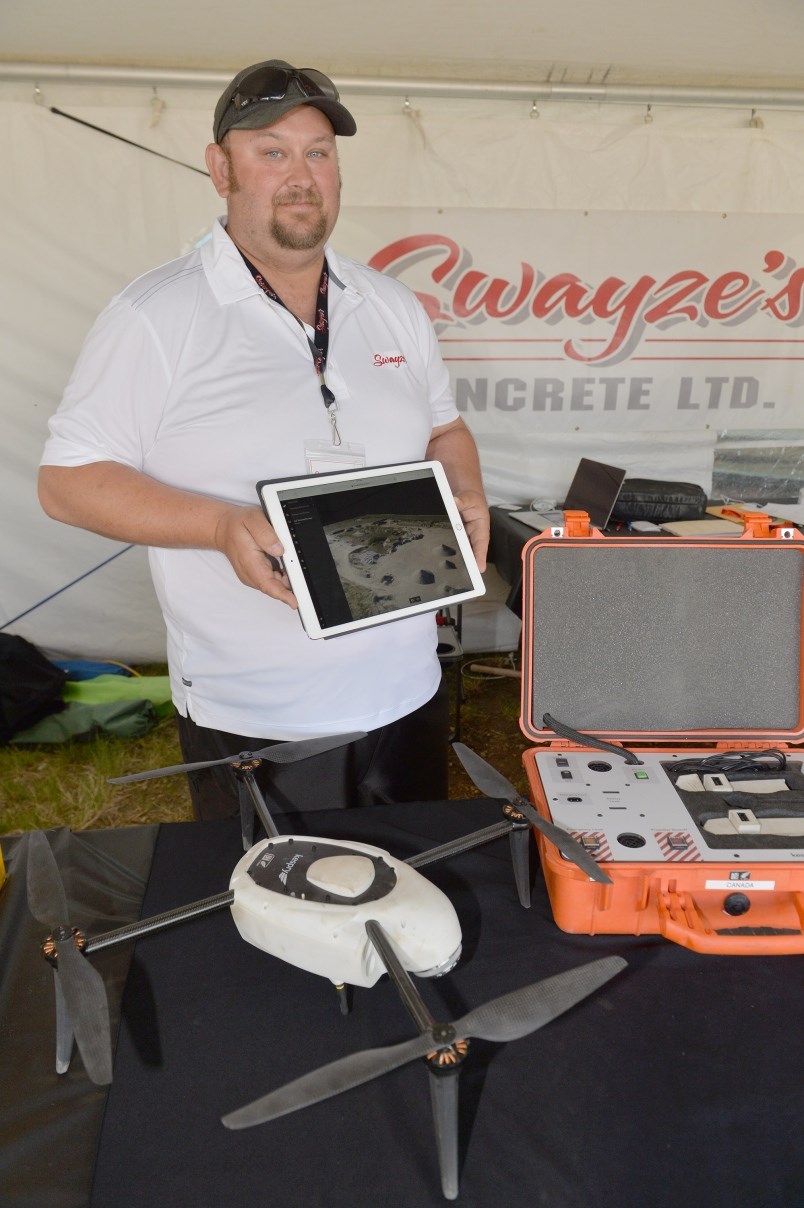Redvers – Swayze Construction has found that applying cutting edge drone technology to measuring piles has dramatically cut time, expense, effort, and the possibility of injury compared to the old-fashioned way of walking piles.
The Carnduff-based firm had its drone on display at the Redvers Oil Showcase on May 30-31. Jamie Didrick is their crusher manager, based in Carnduff. Randy Swayze runs the business with his brother, Ryan, who operates out of Weyburn.
Didrick said they got their drone two years ago in October, and started to use it right away. The payoff was immediate.
“We used to walk the piles with a Topcon,” he said, referring to a surveying device.
When deploying the drone, you set a bounding box on the iPad screen, picking four points on a box for it to fly within. It sets a hard boundary that the drone will not stray from. The drone takes pictures constantly. Those images are pieced together in the software, creating a 3-D model of the terrain below it.
Once the model is created, you can select the pile of material you want to measure and draw a polygon around it. This can be done on the iPad, but they find it’s easier on a computer. You can change the units to cubic metres, cubic yards, tons, or whatever you require.
Didrick said the volumes it measures are accurate to within one per cent, as opposed to two to three per cent with the old method. And that makes a difference.
“The first year I did 213 flights, so almost daily,” Didrick said. “Three times a week for sure.”
They measure piles for rural municipalities and other customers.
“It’s a lot better than walking it, too, because we can measure it when we’re halfway through, or when we think we’re getting close. And if we need to add another 1,000 yards to what our pile is, we can fly it right away again,” he said. '
“Whereas walking it takes a lot. It’s strenuous, and it’s hard on the body.”
The site he showed as an example took 26 minutes to fly, with 32 piles. He explained, “That would take you probably a week to walk.”
“It’s far safer, too” said Swayze. “In winter time, piles are frozen, so when you try to climb a frozen pile, you slide off.”
Didrick said, “Even in the summer, rock is unsure footing. You save time, you save money and you save people. Lots of times you would have two people.”
“I’ve flown it in -21 C. It eats the batteries faster. It’ll fly in 40 kilometre winds, too. But I wouldn’t go out with a lot of wind in the winter.”
“The nice thing about this is we don’t fly it. It goes on a grid. If it gets off that grid, if it blows off that line it’s supposed to be on, it will shut down and return home. You can send it back up and it will go to that spot it left off.
“We don’t own it. We pay a lease per year from a company from San Francisco. We pay $25,000 American.”
That comes with the software and continual upgrades, as well as insurance and permitting. And compared to a WCB claim for a worker hurting their ankle, this is a good deal.
They have all the necessary permits to fly throughout Saskatchewan, excluding restricted airspace like near the Regina Airport and 15 Wing Moose Jaw.
“It’s been great. It’s saved us so much time,” Swayze said.
“This is the future,” Didrick said.
“Because we have this system, we would have never tried to measure 200-some piles in one year. Whereas now, we can do 207 flights a year. You saw that one pit, with 30 piles in one pit.”
Didrick said, “We also use it for drainage. It shoots elevations. We don’t survey with it. We’re not surveyors by any means. But I’ve had people ask me to do drainage ditches so they can see where they need to take out (material) so they can drain to get their water off. Plus, we’ve done dugouts. It works great for dugouts, because it’s the reverse of a pile, right? To see how much clay they’ve taken out, we’ve done that too. It’s a busy tool.”
“We use it for pit planning. Before I bid a job, I can take this and we fly it and I can basically get the information we need to bid the job properly. Whereas before, you would drive in, look and guess. Now it’s more precise,” Swayze concluded.




